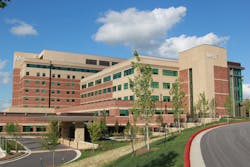Large-scale system integration projects offer integrators both tremendous opportunities and challenges. Because of their size and complexity, these projects can be very lucrative for the firm that gets the job, which means the competition to land the project will likely be intense. Few facilities have more demanding and complicated specifications for their building automation and security systems than hospitals, so integrating a major healthcare facility requires the utmost knowledge and skill.
For an integrator that has the expertise and staffing to handle these jobs, working in a hospital can be very rewarding — not only financially but also on a more personal level. Hospitals are often important institutions in a community and typically have greater longevity than other commercial spaces, so integrators can take pride in their work for years to come.
For the Springfield, Mo., office of C&C Group, participating in the construction of a new hospital in Joplin, Mo., was both challenging and rewarding. The opening in March 2015 of the new Mercy Hospital Joplin marked an important milestone in the recovery of a community that was devastated by a powerful tornado in 2011. The new 900,000-square foot, $465 million, state-of-the-art facility replaces the former St. John’s Regional Medical Center, which was reduced to a shell after the EF-5 tornado hit Joplin. The tornado left in its wake 161 fatalities, more than 1,000 injuries and damages totaling an estimated $2.8 billion in the southwestern Missouri community. Restoring the hospital was important to a city that was struggling after the tornado and was a priority of the Mercy Health System.
Strategies for Tackling a Large Project
Lessons learned by participating in the rebuilding of this community institution can apply to any large-scale healthcare project, not just one recovering from a natural disaster. From bidding, to specing to completing the work, there are actions the integrator should take at each step in the process to ensure the successful completion of the job.
Step 1: Plan Ahead — The first step is to plan ahead and anticipate a major project. Mercy Health System announced almost immediately after the tornado that it would rebuild the destroyed hospital — but it doesn’t take a disaster to know that a hospital will need to be replaced. For public hospitals, any rebuilding or major expansion will require funding through taxes or bonds, and discussions to authorize this funding will occur months if not years before the facility is ready to be built. Similarly, non-profit hospitals may launch fundraising campaigns prior to developing new facilities. Keeping abreast of the news and developments in your community can be a first step in getting ahead start on participating in a large hospital project. C & C Group networked with major electrical contractors in the area, knowing the at least one of them would be on the shortlist for Joplin Hospital. As a result, when Guaranteed Electric of St. Louis was selected, they added C&C Group to the short list of subcontractors it recommended to bid on the integration portion of the project.
Step 2: Review the Specs — Because hospitals are such complex facilities, it is crucial that the integrator has the expertise going in to complete the project. Reviewing the specs is an important step — not only in determining the bid on the project, but also assessing how prepared your firm is to handle a project. When C&C reviewed the specs for the new Mercy Hospital, they discovered that the hospital consistently used standard platforms and equipment across their system. Furthermore, C&C represented two of the standard product lines Mercy uses, so we knew that we had the knowledge base to do the job.
Step 3: The Interview — The interview process for a large hospital project will likely be long and intense. An integrator can expect to be grilled by the general contractor, the electrical contractor and the end-user. During this phase, it is important to demonstrate your expertise, show that you understand the best practices to implement the project, and take advantage of your networking skills. C&C Group accomplished these objectives during the interviews for Mercy by demonstrating our product knowledge and ability to handle large projects — we were already working on the rebuilding of two schools in Joplin and had completed other large projects in the region. Next, we provided step-by-step procedures for completing the project within the short time frame that Mercy had allotted to get the hospital opened. This showed we had taken into account an important aspect of this project that was non-negotiable with the customer.
Step 4: Location Matters — Finally, we leveraged our existing relationships with the other contractors on the job, which were a result of our extensive networking. It was also advantageous that all the companies involved work in the same Midwest region and had offices in the same cities. This allowed Mercy, which is based in St. Louis, to work with other regionally-based companies that were part of its own communities. This is an important consideration for any integrator pursuing a major project that may also generate interest from large, outside firms. Hospitals often have strong community bonds, so emphasizing your local connections can be a real advantage. Even though ours was not the lowest bid, the selection team — including the general and electrical contractors and the security team from Mercy — chose the Springfield-based office of C&C Group as the contractor, demonstrating that having proven expertise and local presence can be the most important assets for your company when pursuing any job.
Inside the Job
The Mercy project was what we refer to as a "parts-and-smarts job," meaning that the labor to run cable and install devices was not part of our contract. Following the component installation, we provided, programmed and commissioned the video surveillance and access control systems within the facility — which included 430 IP cameras, 692 access controlled doors, 92 panic buttons, one video wall, four iris readers, a photo badging station, five video monitoring stations, elevator controls, integration with the hospitals newborn baby monitoring system and 200 TB video storage with failover onto six servers.
Mercy established an aggressive timeline to complete the hospital, so C&C Group devised an efficient plan to commission equipment and train staff even as construction continued on the facility. Commissioning and quality control was implemented on a floor as soon as it was completed, and end-users were on hand during the process to offer input. This enabled the customer to let us know if the system was functioning the way they envisioned it and for us to make changes on the spot if they needed a different functionality.
Staff training was part of the program from the beginning. C&C Group created mock-up devices to train users and even set up cameras on the construction site to use for real-time instruction on using the video monitoring system. This allowed the staff to gain hands-on experience and training with the equipment and BAS before the hospital even opened. By getting a head start on training your customers, you can eliminate many call backs for instruction or rebooting after the project is handed over to them.
Convergence of Physical Security and IT Staff
As reliance on IP networks for building systems continues to accelerate, the challenge of combining security and IT networks is becoming a common scenario. This means that systems integrators must be prepared to assist their customers in making the transition.
Historically, IT network staff and security staff in facilities have been protective of their networks and suspicious of each other. IT staff usually felt there are too many devices on the security network and too many user seats as well, which they see as making the network vulnerable. Often, the security staff felt the IT staff wants too many restrictions on the network that inhibit the access users are demanding, such as real-time information available on demand, not just in a command center, but remotely from smartphones or tablets. Systems integrators add real value to projects when they can mediate between these two camps and implement a system that provides the access end-users demand and the security that is imperative for any IT network.
Early in the commissioning process, the Mercy System implemented such a networking change system-wide that impacted the project. Previously, Mercy’s IT and security networks were separate, standalone systems, with hardware contained in distinct spaces. Now, Mercy combined them both into one network backbone with one network room — meaning the IT and security staff would be using the same networks and working closely together, a new experience for both. C&C Group worked closely with both IT and security staff to implement this change, and even though we had to reprogram some commissioned devices, the overall benefit of the network change to the customer made the implementation worth it for all parties.
Best Practices
The successful completion of the systems integration at Mercy Hospital in Joplin offers important lessons for any integrator taking on a large, complex project. Here are the takeaways:
- Network with electrical, mechanical and general contractors who are likely to be working on a large project you know is imminent.
- Understand the equipment the potential customer typically uses and the level and complexity of their typical integration.
- Recognize your expertise and be prepared to demonstrate what you know to the potential customer; let them see that your company is the firm to do the job.
- Highlight ties to the community and relationships with the other contractors involved with the project; show the customer you will be part of the team.
- Provide detailed plans to execute the project; demonstrate that you have already devised strategies to cover specific challenges of the project.
- Implement effective training early on to get the facility team up and running as soon as possible in the new building, this will reduce call-backs and enhance customer satisfaction.
The Mercy Hospital project presented special challenges, notably the tight deadline for completion. By applying our systems integration expertise and implementing an effective training program during the integration, the facility staff was fully prepared for the hospital opening. C&C Group had a small team on hand to support the hospital staff, but communications, planning and education resulted in few problems as the facility opened to staff and patients.
For any hospital or other large-scale integration, careful planning and execution will mitigate problems and result in a successful implementation, which will also result in ongoing operational success as well.
Paul Strohm is past president of the InsideIQ Building Automation Alliance (www.insideiq.org), an international alliance of independent building and facility automation companies representing common automation and security system platforms. Strohm is also president and COO of C&C Group, a facility services provider in the Midwest with offices in both Kansas and Missouri.



